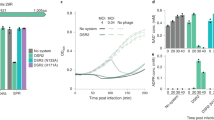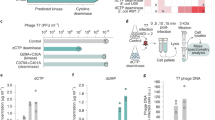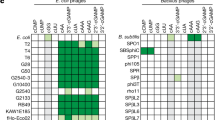Abstract
Bacteria defend against phage infection through a variety of antiphage defence systems1. Many defence systems were recently shown to deplete cellular nicotinamide adenine dinucleotide (NAD+) in response to infection, by cleaving NAD+ into ADP-ribose (ADPR) and nicotinamide2,3,4,5,6,7. It was demonstrated that NAD+ depletion during infection deprives the phage of this essential molecule and impedes phage replication. Here we show that a substantial fraction of phages possess enzymatic pathways allowing reconstitution of NAD+ from its degradation products in infected cells. We describe NAD+ reconstitution pathway 1 (NARP1), a two-step pathway in which one enzyme phosphorylates ADPR to generate ADPR pyrophosphate (ADPR-PP), and the second enzyme conjugates ADPR-PP and nicotinamide to generate NAD+. Phages encoding NARP1 can overcome a diverse set of defence systems, including Thoeris, DSR1, DSR2, SIR2–HerA and SEFIR, all of which deplete NAD+ as part of their defensive mechanism. Phylogenetic analyses show that NARP1 is primarily encoded on phage genomes, suggesting a phage-specific function in countering bacterial defences. A second pathway, NARP2, allows phages to overcome bacterial defences by building NAD+ using metabolites different from ADPR-PP. Our findings reveal a unique immune evasion strategy in which viruses rebuild molecules depleted by defence systems, thus overcoming host immunity.
This is a preview of subscription content, access via your institution
Access options
Access Nature and 54 other Nature Portfolio journals
Get Nature+, our best-value online-access subscription
$29.99 / 30 days
cancel any time
Subscribe to this journal
Receive 51 print issues and online access
$199.00 per year
only $3.90 per issue
Buy this article
- Purchase on SpringerLink
- Instant access to full article PDF
Prices may be subject to local taxes which are calculated during checkout




Similar content being viewed by others
Data availability
Data that support the findings of this study are available within the Article and Supplementary Tables 1–4. IMG and INPHARED accession numbers, protein sequences and nucleotide sequences are available in Supplementary Tables 1 and 2. Source data are provided with this paper.
References
Millman, A. et al. An expanded arsenal of immune systems that protect bacteria from phages. Cell Host Microbe 30, 1556–1569 (2022).
Garb, J. et al. Multiple phage resistance systems inhibit infection via SIR2-dependent NAD+ depletion. Nat. Microbiol. 7, 1849–1856 (2022).
Ofir, G. et al. Antiviral activity of bacterial TIR domains via immune signalling molecules. Nature 600, 116–120 (2021).
Zaremba, M. et al. Short prokaryotic Argonautes provide defence against incoming mobile genetic elements through NAD+ depletion. Nat. Microbiol. 7, 1857–1869 (2022).
Gao, L. A. et al. Prokaryotic innate immunity through pattern recognition of conserved viral proteins. Science 377, eabm4096 (2022).
Morehouse, B. R. et al. STING cyclic dinucleotide sensing originated in bacteria. Nature 586, 429–433 (2020).
Tal, N. et al. Cyclic CMP and cyclic UMP mediate bacterial immunity against phages. Cell 184, 5728–5739 (2021).
Chen, Y. et al. From bacteria to biomedicine: developing therapies exploiting NAD+ metabolism. Bioorg. Chem. 142, 106974 (2024).
Erhardt, H. et al. Organization of the Escherichia coli aerobic enzyme complexes of oxidative phosphorylation in dynamic domains within the cytoplasmic membrane. MicrobiologyOpen 3, 316–326 (2014).
Rodionova, I. A. et al. Metabolic and bactericidal effects of targeted suppression of NadD and NadE enzymes in mycobacteria. mBio 5, e00747-13 (2014).
Mikolcevic, P., Hlousek-Kasun, A., Ahel, I. & Mikoc, A. ADP-ribosylation systems in bacteria and viruses. Comput. Struct. Biotechnol. J. 19, 2366–2383 (2021).
Wilkinson, A., Day, J. & Bowater, R. Bacterial DNA ligases. Mol. Microbiol. 40, 1241–1248 (2001).
Rousset, F. et al. A conserved family of immune effectors cleaves cellular ATP upon viral infection. Cell 186, 3619–3631 (2023).
Maffei, E. et al. Systematic exploration of Escherichia coli phage-host interactions with the BASEL phage collection. PLoS Biol. 19, e3001424 (2021).
Iyer, L. M., Burroughs, A. M., Anantharaman, V. & Aravind, L. Apprehending the NAD+–ADPr-dependent systems in the virus world. Viruses 14, 1977 (2022).
Gazzaniga, F., Stebbins, R., Chang, S. Z., McPeek, M. A. & Brenner, C. Microbial NAD metabolism: lessons from comparative genomics. Microbiol. Mol. Biol. Rev. 73, 529–541 (2009).
Tang, D. et al. Multiple enzymatic activities of a Sir2-HerA system cooperate for anti-phage defense. Mol. Cell 83, 4600–4613 (2023).
Galeazzi, L. et al. Identification of nicotinamide mononucleotide deamidase of the bacterial pyridine nucleotide cycle reveals a novel broadly conserved amidohydrolase family. J. Biol. Chem. 286, 40365–40375 (2011).
Raffaelli, N. et al. The Escherichia coli NadR regulator is endowed with nicotinamide mononucleotide adenylyltransferase activity. J. Bacteriol. 181, 5509–5511 (1999).
Khorana, H. G., Fernandes, J. F. & Kornberg, A. Pyrophosphorylation of ribose 5-phosphate in the enzymatic synthesis of 5-phosphorylribose 1-pyrophosphate. J. Biol. Chem. 230, 941–948 (1958).
Yirmiya, E. et al. Phages overcome bacterial immunity via diverse anti-defence proteins. Nature 625, 352–359 (2024).
Revollo, J. R., Grimm, A. A. & Imai, S. The NAD biosynthesis pathway mediated by nicotinamide phosphoribosyltransferase regulates Sir2 activity in mammalian cells. J. Biol. Chem. 279, 50754–50763 (2004).
Hove-Jensen, B. et al. Phosphoribosyl diphosphate (PRPP): biosynthesis, enzymology, utilization, and metabolic significance. Microbiol Mol Biol Rev 81, e00040-16 (2017).
Sabonis, D. et al. TIR domains produce histidine-ADPR conjugates as immune signaling molecules in bacteria. Preprint at bioRxiv https://www.biorxiv.org/content/10.1101/2024.01.03.573942v1 (2024).
Cook, R. et al. INfrastructure for a PHAge REference Database: identification of large-scale biases in the current collection of cultured phage genomes. Phage 2, 214–223 (2021).
Lee, J. Y., Li, Z. & Miller, E. S. Vibrio phage KVP40 encodes a functional NAD+ salvage pathway. J. Bacteriol. 199, e00855-16 (2017).
Gao, Z. & Feng, Y. Bacteriophage strategies for overcoming host antiviral immunity. Front. Microbiol. 14, 1211793 (2023).
Mayo-Munoz, D., Pinilla-Redondo, R., Camara-Wilpert, S., Birkholz, N. & Fineran, P. C. Inhibitors of bacterial immune systems: discovery, mechanisms and applications. Nat. Rev. Genet. 25, 237–254 (2024).
Zhang, F., Song, G. & Tian, Y. Anti-CRISPRs: the natural inhibitors for CRISPR-Cas systems. Animal Model. Exp. Med. 2, 69–75 (2019).
Hobbs, S. J. et al. Phage anti-CBASS and anti-Pycsar nucleases subvert bacterial immunity. Nature 605, 522–526 (2022).
Huang, N. et al. Structure and function of an ADP-ribose-dependent transcriptional regulator of NAD metabolism. Structure 17, 939–951 (2009).
Rodionov, D. A. et al. Transcriptional regulation of NAD metabolism in bacteria: NrtR family of Nudix-related regulators. Nucleic Acids Res. 36, 2047–2059 (2008).
Tal, N. et al. Bacteria deplete deoxynucleotides to defend against bacteriophage infection. Nat. Microbiol. 7, 1200–1209 (2022).
Goldstone, D. C. et al. HIV-1 restriction factor SAMHD1 is a deoxynucleoside triphosphate triphosphohydrolase. Nature 480, 379–382 (2011).
Heer, C. D. et al. Coronavirus infection and PARP expression dysregulate the NAD metabolome: an actionable component of innate immunity. J. Biol. Chem. 295, 17986–17996 (2020).
Brenner, C. Viral infection as an NAD+ battlefield. Nat. Metab. 4, 2–3 (2022).
Minh, B. Q., Nguyen, M. A. & von Haeseler, A. Ultrafast approximation for phylogenetic bootstrap. Mol. Biol. Evol. 30, 1188–1195 (2013).
Chung, C. T., Niemela, S. L. & Miller, R. H. One-step preparation of competent Escherichia coli: transformation and storage of bacterial cells in the same solution. Proc. Natl Acad. Sci. USA 86, 2172–2175 (1989).
Doron, S. et al. Systematic discovery of antiphage defense systems in the microbial pangenome. Science 359, eaar4120 (2018).
Hove-Jensen, B., Bentsen, A. K. & Harlow, K. W. Catalytic residues Lys197 and Arg199 of Bacillus subtilis phosphoribosyl diphosphate synthase. Alanine-scanning mutagenesis of the flexible catalytic loop. FEBS J. 272, 3631–3639 (2005).
Eriksen, T. A., Kadziola, A., Bentsen, A. K., Harlow, K. W. & Larsen, S. Structural basis for the function of Bacillus subtilis phosphoribosyl-pyrophosphate synthetase. Nat. Struct. Biol. 7, 303–308 (2000).
Adler, B. A. et al. Broad-spectrum CRISPR-Cas13a enables efficient phage genome editing. Nat. Microbiol. 7, 1967–1979 (2022).
Leavitt, A. et al. Viruses inhibit TIR gcADPR signalling to overcome bacterial defence. Nature 611, 326–331 (2022).
Baba, T. et al. Construction of Escherichia coli K-12 in-frame, single-gene knockout mutants: the Keio collection. Mol. Syst. Biol. 2, 2006.0008 (2006).
Thomason, L. C., Costantino, N. & Court, D. L. E. coli genome manipulation by P1 transduction. Curr. Protoc. Mol. Biol. 79, 1.17.1–1.17.8 (2007).
Mazzocco, A., Waddell, T. E., Lingohr, E. & Johnson, R. P. Enumeration of bacteriophages using the small drop plaque assay system. Methods Mol. Biol. 501, 81–85 (2009).
Kitaoka, M. Automatic calculation of the kinetic parameters of enzymatic reactions with their standard errors using Microsoft Excel. J. Appl. Glycosci. 70, 33–37 (2023).
Zheng, L. et al. Fumarate induces redox-dependent senescence by modifying glutathione metabolism. Nat. Commun. 6, 6001 (2015).
Steinegger, M. & Soding, J. MMseqs2 enables sensitive protein sequence searching for the analysis of massive data sets. Nat. Biotechnol. 35, 1026–1028 (2017).
Sievers, F. et al. Fast, scalable generation of high-quality protein multiple sequence alignments using Clustal Omega. Mol. Syst. Biol. 7, 539 (2011).
Nguyen, L. T., Schmidt, H. A., von Haeseler, A. & Minh, B. Q. IQ-TREE: a fast and effective stochastic algorithm for estimating maximum-likelihood phylogenies. Mol. Biol. Evol. 32, 268–274 (2015).
Letunic, I. & Bork, P. Interactive Tree Of Life (iTOL) v4: recent updates and new developments. Nucleic Acids Res. 47, W256–W259 (2019).
Acknowledgements
We thank members of the laboratory of R.S. for comments on earlier versions of this manuscript. R.S. was supported, in part, by the European Research Council (grant number ERC-AdG GA 101018520), the Israel Science Foundation (MAPATS grant 2720/22), the Deutsche Forschungsgemeinschaft (SPP 2330, grant 464312965), a research grant from the Estate of Marjorie Plesset, the Ernest and Bonnie Beutler Research Program of Excellence in Genomic Medicine, the Dr. Barry Sherman Institute for Medicinal Chemistry, M. de Botton, the Andre Deloro Prize and the Knell Family Center for Microbiology. I.O. was supported by the Ministry of Absorption New Immigrant programme. E.Y. is supported by the Clore Scholars Program, and, in part, by the Israeli Council for Higher Education through the Weizmann Data Science Research Center.
Author information
Authors and Affiliations
Contributions
The study was conceptualized and designed by I.O. and R.S. I.O. conducted all phage knockout and knock-in experiments, tested the anti-defence effect of NARP1, purified Adps and Namat proteins and carried out all in vitro experiments. H.S. cloned and measured the anti-defence effect of NARP2. F.R. carried out a phylogenetic analysis of Adps and Namat. E.L. collected and processed samples for LC–MS. M.I. and S.M. carried out all LC–MS experiments. E.Y. identified phages with NARP1 in laboratory phage collection. A.M. collected sequences of Prs and Nampt genes in bacterial and phage genomes. The manuscript was written by I.O. and R.S. All authors contributed to editing the manuscript and support the conclusions.
Corresponding authors
Ethics declarations
Competing interests
R.S. is a scientific cofounder and adviser of BiomX and Ecophage. The other authors declare no competing interests.
Peer review
Peer review information
Nature thanks Charles Brenner, Hening Lin and Malcolm White for their contribution to the peer review of this work.
Additional information
Publisher’s note Springer Nature remains neutral with regard to jurisdictional claims in published maps and institutional affiliations.
Extended data figures and tables
Extended Data Fig. 1 BASEL-collection phages encoding NAD reconstitution pathways.
a. BASEL-collection phages that encode the NARP1 pathway. b. BASEL-collection phages that encode a two-gene operon predicted to comprise NadR and a transporter for nicotinamide riboside. This operon is hypothesized to comprise a phage NAD+ reconstitution pathway that was not examined in the current study.
Extended Data Fig. 2 Mass spectrometry analysis of metabolites detected in lysates from infected cells.
a. A unique molecule with an m/z value of 622.034 appears in SIR2-HerA cells infected by Bas63. Cells were infected at MOI = 10. Bars represent the mean area under the curve (AUC) of three experiments, with individual data points overlaid. b. Extracted mass chromatograms of ions with an m/z value of 622.034 (positive ionization mode) and 620.021 (negative ionization mode) and retention time of 10.2 min. c. MS data in negative ionization mode for the same molecule presented in Fig. 2b. d. MS/MS fragmentation spectra of the molecule with the m/z value 620.021 (negative ionization mode) and 622.034 (positive ionization mode). The hypothesized structure of the molecule and MS/MS fragments are presented.
Extended Data Fig. 3 Characterization of the Adps and Namat enzymes.
a. An SDS-PAGE gel showing the purified Adps (predicted Mw of 32.1 kDa including the 6xhis tag) and Namat (56.6 kDa including the 6xhis tag). For gel source data, see Supplementary Fig. 1. b. A plot of the velocity (µmol* min−1*mg−1) of AMP production by Adps in various concentrations of ADPR in the presence of 100 µM ATP. c. A plot of the velocity (µmol*min−1*mg−1) of AMP production by Adps in various concentrations of ATP in the presence of 100 µM ADPR. In both panels b and c, the appearance of AMP was measured by the AMP-Glo assay (Promega) d. A plot of the velocity (µmol*min−1*mg−1) of NAD production by Namat in various concentrations of nicotinamide in the presence of 100 µM ADPR-PP. e. A plot of the velocity (µmol*min−1*mg−1) of NAD production by Namat in various concentrations of ADPR-PP in the presence of 100 µM nicotinamide. Steady-state kinetic parameters were evaluated by fitting the Michaelis-Menten or Hill equations to data generated by 3 independent measurements using the Enzyme_Kinetics_Calculator47. Individual data points are overlaid on the curves.
Extended Data Fig. 4 Enzymatic treatment of NARP1 products.
a. Schematic of the reactions and mass-chromatograms of ADPR-PP and ADPR-cP following incubation with the enzyme NudC. Representative chromatograms of three replicates are presented. b. Schematic of the reactions and mass-chromatograms of ADPR-PP and ADPR-cP following incubation with the enzyme Apyrase. The peak with m/z 622.034 and retention time 11.0 is hypothesized to correspond to fragmentation of ADPR-PP by ionization in mass spectrometer. Representative chromatograms of three replicates are presented.
Supplementary information
Supplementary Fig. 1
Uncropped protein gel of the results of the Adps and Namat purification.
Supplementary Table 1
List of Adps homologues.
Supplementary Table 2
List of Namat homologues.
Supplementary Table 3
List of strains, plasmids and phages used in this study.
Supplementary Table 4
List of primers used in this study.
Rights and permissions
Springer Nature or its licensor (e.g. a society or other partner) holds exclusive rights to this article under a publishing agreement with the author(s) or other rightsholder(s); author self-archiving of the accepted manuscript version of this article is solely governed by the terms of such publishing agreement and applicable law.
About this article
Cite this article
Osterman, I., Samra, H., Rousset, F. et al. Phages reconstitute NAD+ to counter bacterial immunity. Nature (2024). https://doi.org/10.1038/s41586-024-07986-w
Received:
Accepted:
Published:
DOI: https://doi.org/10.1038/s41586-024-07986-w
Comments
By submitting a comment you agree to abide by our Terms and Community Guidelines. If you find something abusive or that does not comply with our terms or guidelines please flag it as inappropriate.



